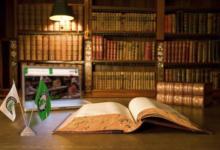Digital education is a necessity and an objective in Syria.

Introduction:
Educational organizations in our current era are systems that grow and change to face new challenges. They are part of a broad process of change and development, where the emergence of modern technologies has been a real driver for change, necessitating the use of new methods to keep up with contemporary changes. Therefore, it is essential to seek new curricula that are suitable for new events, encompassing all cultural, economic, and other fields that require transformation to become a vital demand.
Since the COVID-19 pandemic, we have seen that technology will play an important role in education as part of the digital transformation. Digital transformation can create an effective educational environment that achieves efficient outcomes at the lowest possible cost. Technical education programs are factors for delivering knowledge and science to all learners and a source of shaping the educational present. Moreover, the philosophy of digital education works on spreading digital culture in educational institutions, which, according to specialized studies and statistics, produces active learners. Digital education also contributes to motivating learners to study and achieve.
Therefore, we can easily see the digital transformation, which has become one of the most important fields that educational institutions should adopt to face emergency situations as happened during the COVID-19 pandemic when it played a major role in continuing the educational process. The ease of information exchange and execution of tasks at any time and place is also clearly apparent, contributing to turning routine services into electronic ones, thus expanding the number of beneficiaries. This contributes to achieving scientific additions that participate in raising the scientific performance of teachers and improving educational outcomes, transitioning from traditional methods of information retention to those that suit students.
Digital transformation has become a necessity to solve the problems faced by teachers and students in the educational process and in all fields, eliminating routine and its issues. Digital education aligns with educational theories such as constructivism, which allows learners to build their own knowledge from the surrounding environment. Each learner has a unique way and understanding of the information, not necessarily as perceived by the teacher. Additionally, it provides learners with sufficient background to help them reach an educational theory where the teacher places learners in challenging events that encourage them to produce explanations and form their own ideas, making them active in the learning process. Learners do not just absorb knowledge but uncover it through experiences.
Therefore, education is not just about memorizing and repeating information, but about transferring information to the learner, who processes it. Here, the teacher’s role is to guide the educational process, which is what we aim to highlight in this article.
The Nature of Digital Transformation:
Academic definitions summarize digital transformation as the process of converting data into a digital form to be processed by electronic computers, including converting printed texts into images.
It should be noted that most countries have moved towards digital transformation to facilitate modern technologies’ tasks and improve services, especially after the revolution of artificial intelligence and remote control.
The continued operation of most educational, commercial, and economic sectors… and digital transformation is a means of integrating technology with individuals, using digital technologies in all areas of life, leading to developments within them.
Digital Transformation in Education:
Using information technology to improve institutional performance through comprehensive, deep methods that change activities and models to benefit from technology and its impacts strategically represents digital transformation in education. It also includes curricula, teaching methodologies, and the general environment, all of which are subject to modification to prepare students to become active members of the information society.
Harnessing technology is one of the most important elements of digital transformation, as students and teachers are provided with digital devices to improve educational quality.
Some researchers see digital transformation as effectively applying technologies that enable the learner to focus on education and achieve academic success. Digital learning aims to change education fundamentally, allowing learners to engage with high-quality digital content, fast internet access, and the use of information systems, with the primary goal of shifting learning towards self-learning.
Another important point is the difference between digital and traditional educational materials. Digital educational materials allow for greater interaction between the learner and the material, with great flexibility and characteristics that enable the dissemination and adaptation of learning according to diverse learners’ needs, especially students with special needs or those from poor or remote areas.
Contemporary Educational Technical Tools:
It is important to clarify the tools for managing the educational process online, such as:
- Moodle Platform: A significant modern electronic system for teachers and students, enabling information and lesson exchange. It is an educationally designed learning system that helps teachers provide an educational and electronic environment and is one of the most important digital learning management systems.
- Google Classroom: A free application for all users with a personal account, aiding communication between students and teachers, facilitating visual and light communication between teacher and learner, with features such as easy setup, time-saving, improved organization, and enhanced communication.
Such platforms and others contribute to diversifying information and sources that enable students to research and meet individual educational needs, providing information in various forms and mediums such as videos, and audio, developing critical thinking and creativity skills, and creating a cultural and linguistic environment using modern technologies.
Conclusion:
In Syria, we suffer from a frightening percentage of a generation distant from education. According to a study by the Omran Center on the needs of the post-war generation in northwestern Syria, 13% of children do not know school, and the dropout rate in middle and secondary stages is three-quarters of the students. Therefore, at the Family Affairs Office in the Syrian Future Movement (SFM), we see the necessity of developing education towards complete digital transformation, or at least socially and internationally acceptable, and easily accessible by the public. We call for this transformation to encompass all of Syria, as a non-profit institution run by independent Syrians or with funding and support from the United Nations, ensuring education is designed to prepare students to engage with society and the labor market. We recommend focusing on the following:
- Correcting the misconception of educational technology and digital transformation.
- Diagnosing the educational problems faced by teachers and students, understanding their magnitude and causes, and overcoming them.
- Attention to digital educational institutions in terms of location, recognition, and maintaining traditional education until this transformation is achieved, equipping traditional education with the requirements for using technology as a first and transitional stage.
- Strong will and desire for change and development, and acceptance of change, to make Syria a beacon in the field of studied digital education.
In the Syrian Future Movement (SFM), we emphasize the priority of transitioning to digital education for decision-makers, especially political and international powers, and those interested in child and family issues.
Waheba Al-Masri
Family Affairs Office
Syrian Future Movement (SFM)
References:
- Alaa Abdulkhaleq Hussein Al-Mandalawi, University of Baghdad, 2014, electronic study.
- Abdel Hadi Al-Sayed, The Glow of Learning, Influences, and Necessities, 2022, Anglo Egyptian, Egypt.
- Youssef Jaber Alawna, E-Learning and Its Contemporary Challenges, 2022, Amman.
- Martiz, Ana Laura, et al., ICT Policy Guidelines for Education and Main Plans, 2023, UNESCO.
- Hala Haj Ali, Needs of the Post-War Generation, Educational Gaps in Northwestern Syria as a Model, 2023, Omran Center for Strategic Studies.





